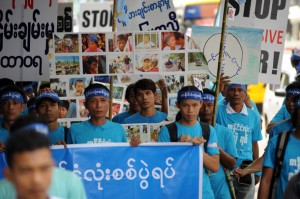17-23 September: The Long Road to Ending Armed Conflict in Burma
September 24, 2012
On 21 September, people around the world marked the United Nations’ International Day of Peace, a day that highlighted just how far there remains to go to achieve lasting peace in Burma.
While Daw Aung San Suu Kyi was being feted on her first trip to the US in more than two decades, Kachin community members called on Daw Suu to do more for the people in Kachin State. As many as 90,000 people have been displaced due to armed conflict between the Burma Army and the Kachin Independence Army, and have little access to urgently needed humanitarian assistance.
Hundreds of protesters gathered in Rangoon on 21 September to call for peace in Burma, and especially in Kachin State. They wore blue headbands and carried signs reading “Stop Civil War” and “Justice Guarantees Lasting Peace” as they walked from City Hall to Inya Lake. Another group of protesters were stopped from traveling to Naypyidaw where they had planned to protest in front of the office of the Burma Army’s Commander-in-Chief; they instead joined the main group.
While authorities did not stop the main protest in Rangoon, the police later questioned 15 activists and have filed charges against them for violating Article 18 of the problematic Law Relating to Peaceful Assembly and Peaceful Procession for . The activists say that they had applied for permission to protest and submitted all the necessary documents, but had been denied by authorities without being given any reason.
The previous day, a performance artist wrapped himself in blue duct tape and walked around Mandalay, also calling for peace. He was arrested by police and released later the same day.
The Karen National Union marked the International Day of Peace by observing a unilateral ceasefire for the day and calling for political dialogue in order to address the root causes of the armed conflict, which was supported by the Karen Women Organization.
Showing the broad support for political dialogue to solve armed conflict, similar calls emerged from the Ethnic Nationalities Conference, which as held from 14 to 16 September. The conference was attended by around 130 representatives from ethnic political parties, armed groups and civil society and concluded with an alternative six-step peace plan to President Thein Sein’s eight-step plan. The proposed peace plan includes the development of a “Framework for Political Dialogue” through consultations with armed ethnic groups, political parties and civil society, holding conventions in States and Regions followed by a national Ethnic Nationalities’ Convention and a Union Conference in the spirit of the 1947 Panglong Agreement. This conference would result in “The Union Accord on Ethnic Nationalities.” The detailed peace plan shows the strength of unity between ethnic political parties, armed groups and civil society representing different ethnic nationality groups.
For there to be fruitful negotiations beyond initial ceasefire agreements with individual armed groups, there must be compromise. The government cannot impose its own peace plan, ignore the desire of ethnic nationalities for a political solution to the armed conflict, and expect to achieve lasting peace.
The government must show its genuine political will to achieve peace by working in partnership with armed ethnic groups to create a level playing field that will be conducive to constructive negotiations. This is the only way to build the confidence necessary to work together towards achieving lasting peace and true national reconciliation.
News Highlights
Daw Aung San Suu Kyi receives the Congressional Gold Medal and meets US President Barack Obama, also meets UN Secretary-General Ban Ki-moon
Daw Aung San Suu Kyi supports the lifting of the remaining US sanctions
Inside Burma
President Thein Sein grants amnesty to 514 prisoners, including at least 80 political prisoners
Burma forms a provisional Myanmar Press Council
Journalists who have been removed from the blacklist are still not able to obtain visas
Regional
International
US removes President Thein Sein and Speaker of the Lower House of Parliament Shwe Mann from the list of sanctioned individuals and House of Representatives approves bill that would allow US to provide assistance through the World Bank, the Asian Development Bank and the International Monetary Fund
European Commission proposes to remove trade restrictions on goods from Burma
Opinions
Suu Kyi’s Silence
By Pangmu Shayi
DVB
Local Kachin Aid Group Goes Where Others Can’t
By Seamus Martov
The Irrawaddy
Latest from the Blog
Refugee Return Only with Consent, Safety and Dignity
By Burma Partnership
Actions
Statements and Press Releases
Burma Prisoner Release Public Relations, Not Reform
By Burma Campaign UK
The Six-Point Political Program of the Ethnic Nationalities Regarding the Peace Process
By Ethnic Nationalities Conference
Burma: Free Remaining Political Prisoners
By Human Rights Watch
Open Letter to UN Secretary-General Ban Ki-moon at High-level UN Meeting on the Rule of Law
By Kachin National Organization
KNU Statement on International Day of Peace
By Karen National Union
Just Saying Peace is Not Enough, It Needs All of Us to Take Action
By Karen Women Organization
Mae Tao Clinic Issues Clarification of Position and Recent Meetings with the Myanmar Peace Team
By Mae Tao Clinic
“None Should be Left Behind” – UN Expert Welcomes Latest Release of Prisoners of Conscience in Myanmar
By Tomás Ojea Quintana
ျမန္မာႏိုင္ငံ ႏိုင္ငံေရးအက်ဥ္းသားမိသားစုမ်ား အက်ဳိးေဆာင္ကြန္ယက္ သတင္းထုတ္ျပန္ခ်က္
By ျမန္မာႏိုင္ငံ ႏိုင္ငံေရးအက်ဥ္းသားမိသားစုမ်ား အက်ဳိးေဆာင္ကြန္ယက္
Reports
Burma’s Parliament: Fundamental Reforms Still Blocked
By Altsean-Burma
Law on Assembly and Procession Inconsistent with Human Rights
By Article 19
Briefing Regarding Myanmar Peace Team’s Meetings with Mae Tao Clinic Team
By Mae Tao Clinic
This post is in: Weekly Highlights









 All posts
All posts